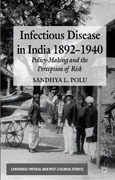
Infectious disease in India, 1892-1940: policy-making and the perception of risk
Polu, Sandhya L.
Long before the terms global health, biosecurity, and public health preparedness came into existence, European and colonial governments struggled to contain and prevent the spread of epidemic diseases from India to the western world.The significance of India to Europe - commercially, epidemiologically, strategically - meant that India occupied a central position in debates on the control of epidemic diseases, becoming a focus of international concern and regulation. European anxieties grew during the later colonial period as increased global trade and faster transportation heightened the risk that these diseases would spread from India to Europe. Risk and fear, however, were not limited to European states. The colonial government in India recognized that infectious diseases posed certain risks to its ability to govern and to the colonial economy. This book uses case studies of cholera, plague, malaria, and yellow fever to analyze how factors such as health diplomacy, epidemiology, trade, imperial governance, medical technologies, and cultural norms, operated within global and colonial conceptions of risk to shape infectious disease policies in colonial India. INDICE: Acknowledgements .List of Abbreviations.Introduction .All Eyes on India .Plague and Cholera - The Epidemic versus the Endemic.Malaria - India's True Plague .From Panama to Khartoum - Yellow Fever Inches Closer to Home.Disease as Prism .Epilogue: Swine Flu Redux.Notes.Bibliography .Index.
- ISBN: 978-0-230-35460-9
- Editorial: Palgrave Macmillan
- Encuadernacion: Cartoné
- Páginas: 240
- Fecha Publicación: 06/04/2012
- Nº Volúmenes: 1
- Idioma: Desconocido
